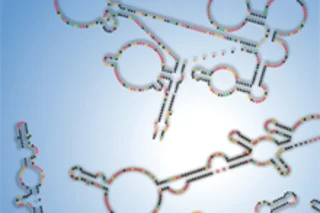The genome of an HIV virus is a truly twisted thing, but now for the first time researchers have traced its every fold and contour. By mapping its entire structure, they hope to gain
a greater understanding of how the virus operates, and potentially accelerate the development of drug treatments [BBC News].
Usually geneticists focus on the sequence of genes that comprise an organism's genome, but recent evidence suggests that the structure can also play a role in how it functions. Like many other viruses, the HIV genome consists of single-strand RNA, rather than the double-stranded DNA found in most animals. Though
scientists have identified HIV’s genes and their order, just one-fifth of its genome has been described in precise spatial detail. That’s important because genomes don’t look anything like the neatly linear, bar code-like pictures returned by basic sequencing techniques. In reality, genomes are arranged in intricate, three-dimensional loops ...














